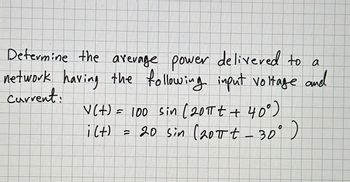
College Physics
11th Edition
ISBN: 9781305952300
Author: Raymond A. Serway, Chris Vuille
Publisher: Cengage Learning
expand_more
expand_more
format_list_bulleted
Question
thumb_up100%

Transcribed Image Text:**Determine the Average Power Delivered to a Network**
To calculate the average power delivered to a network, consider the following input voltage and current:
- Voltage: \( V(t) = 100 \sin(20\pi t + 40^\circ) \)
- Current: \( i(t) = 20 \sin(20\pi t - 30^\circ) \)
These expressions represent time-varying signals where:
- \( V(t) \) represents the voltage as a sinusoidal function with an amplitude of 100 volts, angular frequency of \( 20\pi \), and a phase shift of \( 40^\circ \).
- \( i(t) \) represents the current as a sinusoidal function with an amplitude of 20 amperes, angular frequency of \( 20\pi \), and a phase shift of \(-30^\circ \).
The objective is to determine the average power based on the given equations for voltage and current.
Expert Solution
This question has been solved!
Explore an expertly crafted, step-by-step solution for a thorough understanding of key concepts.
Step by stepSolved in 3 steps with 2 images

Knowledge Booster
Learn more about
Need a deep-dive on the concept behind this application? Look no further. Learn more about this topic, physics and related others by exploring similar questions and additional content below.Similar questions
- An uncharged capacitor and a resistor are connected in series to a source of emf. If = 8.00 V, C = 25.0 µF, and R = 100 Ω, find the following. (a) the time constant of the circuit Your response is off by a multiple of ten. ms(b) the maximum charge on the capacitor µC(c) the charge on the capacitor at a time equal to one time constant after the battery is connected µCarrow_forwardIn the circuit diagram R1 = 5R and R2 = 15R, where R = 14 Ω. The power dissipated in resistor 2 is P = 1.6 W. Part (a) What is the voltage across the battery in volts? Part (b) How much power, Ps, is the source supplying, in watts?arrow_forwardTwo capacitors in the circuit shown is C1= 7.5 µF and C 2=12.5 µF connected to two resistors is R1 = 5 kn and R2 = 7 kn and the battery emf is AV= 350 V (a) Calculate the time constant, (b) Calculate the maximum charge the Qmax capacitor could acquire, (c) Find time, it takes for the capacitance charge Q(t) to reach 68 % of the maximum charge Qmax- (d) Plot the current I when the charge Q(t) respect to time (t) R1 C C, HHI R2 AV Sarrow_forward
arrow_back_ios
arrow_forward_ios
Recommended textbooks for you
 College PhysicsPhysicsISBN:9781305952300Author:Raymond A. Serway, Chris VuillePublisher:Cengage Learning
College PhysicsPhysicsISBN:9781305952300Author:Raymond A. Serway, Chris VuillePublisher:Cengage Learning University Physics (14th Edition)PhysicsISBN:9780133969290Author:Hugh D. Young, Roger A. FreedmanPublisher:PEARSON
University Physics (14th Edition)PhysicsISBN:9780133969290Author:Hugh D. Young, Roger A. FreedmanPublisher:PEARSON Introduction To Quantum MechanicsPhysicsISBN:9781107189638Author:Griffiths, David J., Schroeter, Darrell F.Publisher:Cambridge University Press
Introduction To Quantum MechanicsPhysicsISBN:9781107189638Author:Griffiths, David J., Schroeter, Darrell F.Publisher:Cambridge University Press Physics for Scientists and EngineersPhysicsISBN:9781337553278Author:Raymond A. Serway, John W. JewettPublisher:Cengage Learning
Physics for Scientists and EngineersPhysicsISBN:9781337553278Author:Raymond A. Serway, John W. JewettPublisher:Cengage Learning Lecture- Tutorials for Introductory AstronomyPhysicsISBN:9780321820464Author:Edward E. Prather, Tim P. Slater, Jeff P. Adams, Gina BrissendenPublisher:Addison-Wesley
Lecture- Tutorials for Introductory AstronomyPhysicsISBN:9780321820464Author:Edward E. Prather, Tim P. Slater, Jeff P. Adams, Gina BrissendenPublisher:Addison-Wesley College Physics: A Strategic Approach (4th Editio...PhysicsISBN:9780134609034Author:Randall D. Knight (Professor Emeritus), Brian Jones, Stuart FieldPublisher:PEARSON
College Physics: A Strategic Approach (4th Editio...PhysicsISBN:9780134609034Author:Randall D. Knight (Professor Emeritus), Brian Jones, Stuart FieldPublisher:PEARSON

College Physics
Physics
ISBN:9781305952300
Author:Raymond A. Serway, Chris Vuille
Publisher:Cengage Learning

University Physics (14th Edition)
Physics
ISBN:9780133969290
Author:Hugh D. Young, Roger A. Freedman
Publisher:PEARSON

Introduction To Quantum Mechanics
Physics
ISBN:9781107189638
Author:Griffiths, David J., Schroeter, Darrell F.
Publisher:Cambridge University Press

Physics for Scientists and Engineers
Physics
ISBN:9781337553278
Author:Raymond A. Serway, John W. Jewett
Publisher:Cengage Learning

Lecture- Tutorials for Introductory Astronomy
Physics
ISBN:9780321820464
Author:Edward E. Prather, Tim P. Slater, Jeff P. Adams, Gina Brissenden
Publisher:Addison-Wesley

College Physics: A Strategic Approach (4th Editio...
Physics
ISBN:9780134609034
Author:Randall D. Knight (Professor Emeritus), Brian Jones, Stuart Field
Publisher:PEARSON